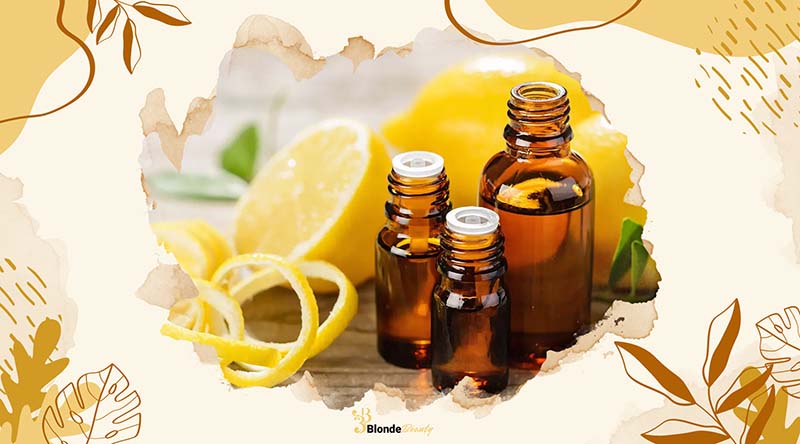Are you fed up with unsightly nails? There are many reasons for the appearance of unattractive nails, including a bothersome fungal infection that attacks the nail bed, forcing you to trim your nails shorter than desired.
While numerous treatments exist for this stubborn fungus, opting for natural, safe, and affordable solutions can alleviate the discomfort associated with toenail fungus.
In this article, we’ll explore the best essential oils for nail fungus and provide natural treatment methods. Additionally, we’ll share some easy homemade DIY recipes so you can effectively use these antifungal essential oils. Not only will you be able to heal your unsightly nails, but you can also prevent future infections.
You should also read the following articles:
- Nail Split Down the Middle Vertically: Overview and Solution
- Does Vitamin E Help Nails Grow? Expert Insights Revealed!
Things to Know Before Using Essential Oils to Treat Nail Fungus
Before exploring the uses of essential oils for nail fungus, consider some key points gathered from reliable sources.
- Quality and Dilution: Opt for top-notch, organically certified essential oils that boast therapeutic grade credentials to ensure you’re not getting diluted products or harmful additives.
- Skin Sensitivity: To steer clear of potential skin reactions or irritations, always dilute essential oils in a carrier oil when applying them directly to the affected area for toenail fungus treatment.
- Patch Test: Prior to full-scale application, perform a patch test on a small, unaffected patch of skin. Wait 24 hours to monitor for any allergic reactions before proceeding with essential oil treatment.
- Consultation: If you encounter any adverse reactions to essential oils, halt usage immediately and seek guidance from a medical professional.
- Pregnancy and Breastfeeding: Expectant or nursing mothers should exercise caution, as the effects of certain essential oils remain uncertain. It’s advisable to consult a healthcare provider before incorporating essential oils into your regimen during these times.
- Frequency and Application: Apply essential oils at least twice daily to the affected nail using a cotton swab. Mix the oil with water or a carrier oil and apply directly to the impacted area.
- Choice of Oils: Several essential oils, including oregano, tea tree, lavender, lemongrass, eucalyptus, lemon, thyme, and peppermint, boast antifungal properties that can effectively combat toenail fungus.
- Proper Hygiene: Uphold proper foot hygiene practices by regularly washing and thoroughly drying your feet, moisturizing your nails, trimming them straight across, and avoiding walking barefoot in public areas to minimize the risk of fungal infection transmission.

11 Essential Oils for Nail Fungus
Aromatherapy, an ancient healing practice, harnesses the therapeutic properties of pure essential oils. These oils, derived from various plant parts such as stems, roots, barks, and nuts, offer a potent blend of organic compounds that can address a range of human ailments. In the case of toenail fungus treatment, these plant-based oils boast antifungal, antibacterial, and antiseptic properties, alongside unique active nutrients that aid in healing damaged nails and promoting natural growth.
In this segment, we’ve curated a selection of essential oils for toenail fungus treatment, endorsed by a respected dermatologist. These oils are renowned for their effectiveness in combating yeast infections and restoring the natural shape of nails. Moreover, they offer additional benefits for the skin, making them indispensable in your nail care regimen. Exploring these antifungal essential oils is essential for anyone seeking to address nail concerns effectively.
Clove Essential Oil
Clove essential oil, characterized by its sharp and pungent aroma and pale yellow hue, is a versatile household staple renowned for its myriad applications, ranging from inflammation treatment to promoting hair growth. This potent oil blends harmoniously with an array of other essential oils, including Basil, Bergamot, Cinnamon Bark, Clary Sage, Lemon, Orange, Grapefruit, Lavender, Peppermint, Rose, Rosemary, and Ylang Ylang.
Benefits of Clove Essential Oil
The benefits of clove essential oil span a wide spectrum, including its ability to combat infections, reduce inflammation in the mouth and throat, boost the immune system, alleviate stress, address respiratory issues, regulate diabetes, diminish acne, and stimulate hair growth.
How to Use Clove Essential Oil
Utilizing clove essential oil is simple yet effective. Add 2-3 drops of clove oil to coconut oil, then apply the mixture to your nail beds and toes. Repeat this process twice daily until you notice a reduction in symptoms.
Side Effects of Clove Essential Oil
However, you should be aware of the potential side effects associated with clove essential oil. Applying it directly to the mouth or gums may lead to damage to the gums, tooth pulp, and skin. Additionally, injecting clove oil into the vein can result in respiratory and lung complications. So, be cautious and follow recommended usage instructions when incorporating clove essential oil into your health care routine.
Lemon Essential Oil
Lemon essential oil, distinguished by its robust citric aroma and typically clear coloration, though it may exhibit green undertones if derived from green lemons, is primarily employed in aromatherapy. Extracted from lemon peel, this oil boasts numerous health benefits and harmonizes well with Eucalyptus, Frankincense, Geranium, Peppermint, Sandalwood, and Ylang Ylang essential oils.
Benefits of Lemon Essential Oil
The benefits of lemon essential oil are extensive, including its ability to detoxify and rejuvenate the skin, soften cuticles, penetrate the cell walls of nail fungus, heal infections, alleviate respiratory conditions, bolster the immune system, and eliminate allergy triggers.
How to Use Lemon Essential Oil
Incorporating lemon essential oil into your routine is straightforward. Combine 10 drops of lemon oil with 1 tablespoon of coconut oil, then apply this mixture daily to the affected area until discoloration and other symptoms dissipate.
Side Effects of Lemon Essential Oil
Applying certain products to sensitive skin can lead to rashes and irritation. Moreover, using these products in high doses may result in adverse effects such as dizziness, vomiting, seizures, and other health issues.

Thyme Essential Oil
Thyme essential oil, presenting in hues ranging from pale yellow to reddish brown, boasts a fresh, sweet, and herbaceous aroma. This versatile oil harmonizes seamlessly with Lavender, Grapefruit, Bergamot, Rosemary, Lemon, and Pine essential oils.
Benefits of Thyme Essential Oil
The benefits of thyme essential oil are manifold, including its capacity to enhance blood circulation, fortify the immune system, regulate blood pressure, support skin health, aid in toenail fungus treatment, and exhibit allergy-fighting properties.
How to Use Thyme Essential Oil
Incorporating thyme essential oil into your regimen is a simple process. Just add 2 drops of thyme oil to any carrier oil, then apply it to the affected area. Allow it to sit for a brief period before gently scrubbing with a soft brush.
Side Effects of Thyme Essential Oil
If consumed, certain products can disrupt the digestive system, causing symptoms like headaches or dizziness in some individuals. Additionally, these products may also trigger skin irritation for some people.
Tea Tree Essential Oil
Tea tree essential oil is characterized by its fresh, camphoraceous odor and a color spectrum ranging from pale yellow to nearly colorless and clear. This versatile oil blends exceptionally well with cinnamon, clary sage, clove, geranium, lavender, rosewood, rosemary, grapefruit, lemon, and thyme essential oils.
Benefits of Tea Tree Essential Oil
The benefits of tea tree essential oil are diverse, encompassing its ability to treat infections, soothe skin conditions, address dandruff and dry scalp, combat acne, reduce inflammation, and alleviate allergy symptoms.
How to Use Tea Tree Essential Oil
Incorporating tea tree essential oil into your routine involves a simple process. Begin by washing the infected nail with warm, soapy water. For those with sensitive skin, it’s advisable to dilute the tea tree oil with a carrier oil. Apply 3-4 drops of this mixture to your nails, allowing it to soak for 10 minutes before gently scrubbing with a soft brush. Repeat this process daily until the new nail replaces the old one.
Side Effects Tea Tree Essential Oil
Consuming tea tree oil can lead to serious side effects including confusion, inability to walk, unsteadiness, rash, and even coma.
Peppermint Essential Oil
Peppermint essential oil is known for its sharp, fresh, and menthol aroma, appearing clear to pale yellow in color. This versatile oil blends seamlessly with Eucalyptus, Geranium, Oregano, Marjoram, Lavender, Lemon, Cypress, Grapefruit, Juniper Berry, Rosemary, and Tea Tree essential oils.
Benefits of Peppermint Essential Oil
The benefits of peppermint essential oil are diverse, including its antifungal properties, efficacy in treating headaches and migraines, ability to combat toenail fungus and alleviate pain, promotion of better sleep, reduction of inflammation, and provision of relief for allergies.
How to Use Of Peppermint Essential Oil
Incorporating peppermint essential oil into your routine is simple. Apply 2-3 drops of peppermint oil to the infected area and repeat the procedure once daily.
Side Effects of Peppermint Essential Oil
Burning mouth syndrome, diarrhea accompanied by anal burning, flushing, and headache, as well as heartburn, are all potential symptoms that can occur from specific triggers or health conditions.

Oregano Essential Oil
Oregano essential oil, extracted from the leaves and flowers of Origanum Vulgare, is renowned for its potent natural antibiotic, antifungal, and antiviral properties, thanks to its high levels of carvacrol and thymol. This powerhouse oil effectively combats bacteria and fungi that can cause skin irritation and infection, acting as a protective shield against harmful germs and fungus. Its versatility and compatibility with all skin types make it a top contender among essential oils for nail fungus.
Benefits of Oregano Essential Oil
The benefits of oregano essential oil extend beyond its antimicrobial properties. It’s prized for its role in natural cleaning products and skincare formulations, with studies suggesting its potential to boost the immune system and alleviate inflammation, thereby easing discomfort associated with conditions like arthritis. Additionally, oregano oil’s antioxidant content helps combat free radicals, which are implicated in various chronic diseases.
How to Use Oregano Essential Oil
Incorporating oregano essential oil into your routine is straightforward. Mix it with a carrier oil, such as coconut or olive oil, and apply it to the skin to address fungal infections or inflammations. Always conduct a patch test beforehand to ensure no adverse reactions occur.
Side Effects of Oregano Essential Oil
When applied topically without adequate dilution, substances such as oregano oil can cause irritation or trigger an allergic reaction. Additionally, ingesting oregano oil may lead to gastrointestinal upset and can interact with certain medications.
Lavender Essential Oil
Lavender essential oil is renowned for its sweet, floral, and woody aroma, presenting in a pale yellow hue. This high-quality oil blends seamlessly with a range of other essential oils, including Pine, Lemon, Tangerine, Patchouli, Rose, Geranium, Frankincense, Bergamot, Sweet Orange, Cedarwood, Grapefruit, Rosemary, and Clary Sage.
Benefits of Lavender Essential Oil
The benefits of lavender essential oil are diverse and impactful. It’s lauded for its ability to alleviate anxiety, eliminate foot odor, promote wound healing, exhibit strong antifungal properties, combat inflammation, address allergies, reduce pain, and soothe skin irritation.
How to Use Lavender Essential Oil
Incorporating lavender essential oil into your routine is simple yet effective. Mix 2-3 drops of lavender oil with 1 tablespoon of coconut oil, then apply this mixture to your nails twice daily for a week.
Side Effects of Lavender Essential Oil
Certain products can cause headaches, lead to constipation, increase appetite, and cause skin irritation when used topically.
Eucalyptus Essential Oil
Eucalyptus essential oil is characterized by its clear, sharp, fresh, woody aroma and pale yellow color. This distinctive oil blends harmoniously with a variety of other essential oils, including Cedarwood, Chamomile, Cypress, Juniper, Lavender, Lemon, Marjoram, Geranium, Ginger, Grapefruit, Peppermint, Pine, Rosemary, and Thyme.
Research indicates that inhaling eucalyptus oil can significantly reduce inflammation, pain, and blood pressure.
Benefits of Eucalyptus Essential Oil
The benefits of eucalyptus essential oil are manifold, including its ability to improve respiratory conditions, alleviate cough, ease seasonal allergies, reduce pain and inflammation, combat infection, and enhance mental clarity.
How to Use Eucalyptus Essential Oil
Incorporating eucalyptus essential oil into your routine is simple. Apply it directly to your nail fungus, leave it on for 15 minutes, then gently wash it off. Repeat this process daily.
Side Effects of Eucalyptus Essential Oil
Some individuals may experience skin irritation from certain oils, so it is advisable to perform a patch test on a small area of skin before using the oil extensively.
Orange Essential Oil
Orange essential oil exhibits a pale orange-yellow hue and emits a sweet, citrusy, and uplifting aroma. This versatile oil blends seamlessly with essential oils of cinnamon, cloves, sandalwood, frankincense, ginger, black pepper, and vetiver.
Benefits of Orange Essential Oil
The benefits of orange essential oil encompass a range of therapeutic properties. Its anti-inflammatory attributes make it effective in treating arthritis, while its antifungal properties aid in combating nail fungus and eliminating long-standing nail issues. Additionally, orange essential oil boasts potential anticancer properties, germ-killing abilities, and immune-boosting effects.
How to Use Orange Essential Oil
Incorporating orange essential oil into your routine is straightforward. Simply use a dropper to apply a few drops of the oil directly to your nail, then wash it off after 30 minutes. Repeat this process two or three times daily.
Side Effects of Orange Essential Oil
While orange essential oil generally has minimal side effects, it may cause skin irritation in some individuals. It’s advisable to conduct a skin patch test before widespread use, especially for those with sensitive skin. Pregnant or breastfeeding individuals should consult their healthcare provider before using orange essential oil.

Myrrh Essential Oil
Myrrh essential oil is characterized by its pungent and bitter aroma, with a color spectrum ranging from yellow to amber to dark brown. This potent oil blends harmoniously with frankincense, cinnamon, rosemary, bergamot, and sweet orange oils.
Benefits of Myrrh Essential Oil
The benefits of myrrh essential oil are extensive and impactful. It possesses antimicrobial properties, effectively killing harmful bacteria, while also supporting skin health and healing skin cracks. Myrrh oil promotes the growth of smoother and stronger nails, combats pain and swelling, balances hormone levels, and aids in relaxation and stress relief.
How to Use Myrrh Essential Oil
Incorporating myrrh essential oil into your routine is simple. Mix it with almond oil and apply it to the affected area, leaving it on for 15-20 minutes before gently scrubbing with a toothbrush.
Side Effects of Myrrh Essential Oil
Certain substances can exacerbate a fever, contribute to heart problems, lower blood pressure, or cause uterine bleeding.
Lemongrass Essential Oil
Lemongrass essential oil is characterized by its sweet, lemony aroma and ranges in color from dark yellow to amber to reddish. This versatile oil blends seamlessly with Eucalyptus, Lavender, Melaleuca, Geranium, and Rosemary essential oils.
Benefits of Lemongrass Essential Oil
The benefits of lemongrass essential oil are extensive, thanks to its antibacterial, antifungal, anti-inflammatory, and antioxidant properties. It aids in preventing gastric ulcers and relieving nausea, easing diarrhea, reducing respiratory inflammation, and alleviating various allergy symptoms.
How to Use Lemongrass Essential Oil
Incorporating lemongrass essential oil into your routine is simple. Mix 2-3 drops of lemongrass oil with jojoba oil and use a dropper to apply the mixture to your toe. Repeat this process daily for optimal results.
Side Effects of Lemongrass Essential Oil
Lemongrass oil is generally safe for use, but it can sometimes cause skin irritation or a rash.
Conclusion
Dealing with nail fungus can be both painful and discomforting. While medications and lasers are common treatments, turning to nature for healing can offer a gentler alternative. Opting for the best essential oils for nail fungus available on the market can prove to be an effective remedy for this condition.
These antifungal essential oils not only combat nail infections but also promote healthy, radiant skin. Essential oils are revered for their safety and natural healing properties, but it’s essential to dilute them properly, as their high concentrations can potentially trigger allergies.
By harnessing the power of nature, you can embark on a journey towards healing your toenail fungus while nurturing your overall well-being.
For more insightful articles on health and wellness, be sure to explore additional blogs from Blonde Beauty.

Laureate Professor Clare Collins
Professor Clare Collins is a leading expert in nutrition and dietetics at the School of Health Sciences, part of the College of Health, Medicine and Wellbeing. Her work is changing the way we think about food and health. She grew up as one of nine children and was the first in her family to finish high school and go to college. This background gave her a strong work ethic and a deep appreciation for seizing opportunities.
As the Director of the Hunter Medical Research Institute’s Food and Nutrition Program and a recipient of three NHMRC Research Fellowships, Professor Collins is making a big difference in public health. She focuses on helping people who are often overlooked, using new technologies like apps and online programs to improve their nutrition and reduce the risk of chronic diseases.
Professor Collins is well-respected and has been recognized as a Fellow in four major health and science organizations. She leads a diverse team of experts, including dietitians, computer scientists, and engineers, working together on global health projects.
Her achievements are impressive. She has received over $29 million in research funding, published more than 450 papers, and helped 35 PhD and Master’s students complete their degrees. She’s also active in sharing her knowledge with the public. She has developed tools like the Australian Eating Survey and the Healthy Eating Quiz, and she often appears in the media to talk about nutrition.
PUBLISHED ARTICLES
- Collins, C. (2019). “The Effect of a Pilot Dietary Intervention on Pain Outcomes in Patients Attending a Tertiary Pain Service.”
- Collins, C. (2022). “Variation in cardiovascular disease risk factors among older adults.”
- Collins, C. (2022). “Evaluation of an online intervention for improving stroke survivors’ health-related quality of life: A randomised controlled trial.”
These articles show Professor Collins’s commitment to understanding how better nutrition can improve health. Her work is important for researchers, doctors, and anyone interested in healthy living.
